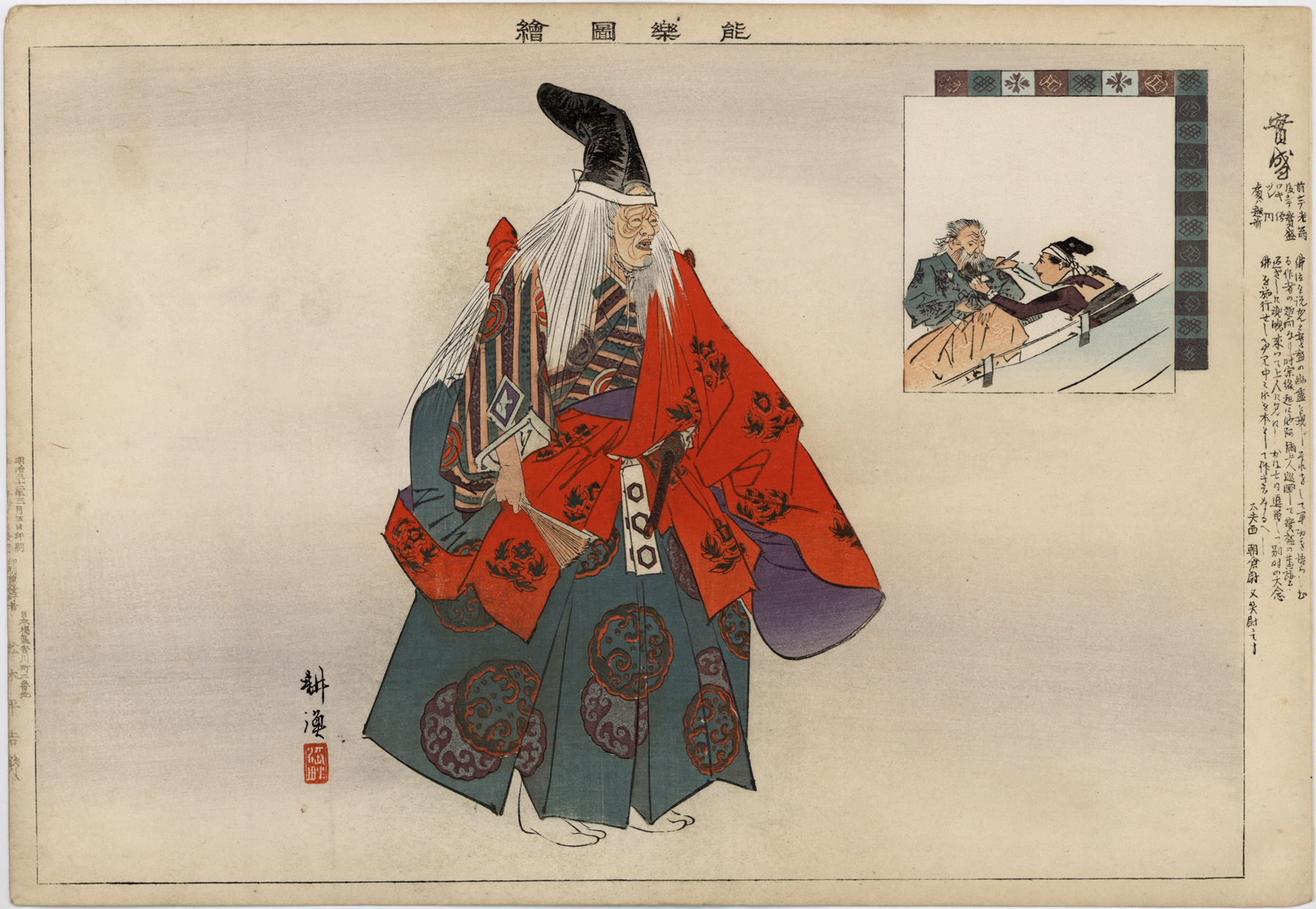About This Print
Right Margin Description of Scene
click on image to enlarge
The Play - Sanemori
Sources: A Guide to No, P.G. O'Neill, Hinoki Shoten, 1929, p. 148-149 and http://www.noh-kyogen.com/story/english/Sanemori.pdf
CharactersAct 1:Waki - the traveling priest Ta-ami ShōninWaki-tsure - two attendant priestsKyōgen (interlude actor) - a local manShite - an old man
Act 2:Nochi-shite - Saitō Bettō Sanemori
SummarySanemori was of the Genji Clan but sided with the losing Heike in 12th century Genji-Heike battles, dying at Shinowara at the age of 72. To hide his age, he dyed his white hair black and also obtained the privilege of wearing brocade robe in battle. The ghost of Sanemori appears before a traveling priest two centuries later, tells how he met his death, and asks to be saved.
DetailsAfter a local person of Shinowara explains in a short prologue that the priest Ta-ami preaches there every day, apparently to himself, the priest begins his sermon. An old man, visible to Ta-ami but to no one else, then comes to listen as he has on every previous day. When asked about himself, he reveals that he is the ghost of the warrior Sanemori who was killed in battle there more than two hundred years ago, and then he vanishes beside the pond in which his head was washed after his death. When the priest prays there through the night for the repose of Sanemori's spirit, the ghost appears and tells the story of his last battle before which, being already an old man at the time, he died his white hair to hide his age.
Characters
Act 1:
Waki - the traveling priest Ta-ami Shōnin
Waki-tsure - two attendant priests
Kyōgen (interlude actor) - a local man
Shite - an old man
Act 2:
Nochi-shite - Saitō Bettō Sanemori
Sanemori was of the Genji Clan but sided with the losing Heike in 12th century Genji-Heike battles, dying at Shinowara at the age of 72. To hide his age, he dyed his white hair black and also obtained the privilege of wearing brocade robe in battle. The ghost of Sanemori appears before a traveling priest two centuries later, tells how he met his death, and asks to be saved.
Details
After a local person of Shinowara explains in a short prologue that the priest Ta-ami preaches there every day, apparently to himself, the priest begins his sermon. An old man, visible to Ta-ami but to no one else, then comes to listen as he has on every previous day. When asked about himself, he reveals that he is the ghost of the warrior Sanemori who was killed in battle there more than two hundred years ago, and then he vanishes beside the pond in which his head was washed after his death. When the priest prays there through the night for the repose of Sanemori's spirit, the ghost appears and tells the story of his last battle before which, being already an old man at the time, he died his white hair to hide his age.
Print Details
| IHL Catalog | #1939 |
| Title | Sanemori 實盛 (The Warrior Sanemori) |
| Series | Nōgakuzue 能樂圖繪 (Illustrations of Noh) |
| Artist | Tsukioka Kōgyo (1869-1927) |
| Signature |  |
| Seal | White letter seal in a rectangular shape with double border: 湖畔 [Kohan], as shown above |
| Date |  Printed on March 5, 1899 / Issued on March 10, 1899 明治三十二年三月五日印刷 / 明治三十二年三月十日發行 |
| Edition | unknown |
| Publisher |  Printed and published 印刷兼發行者 Address 日本橋区吉川町二番地 松木平吉 followed by Daikokuya seal. |
| Carver | |
| Impression | good |
| Colors | excellent |
| Condition | good - minor soiling; album backing paper, left margin partially trimmed |
| Genre | nishiki-e; 能楽図絵 Nōgaku zue [Noh play picture] |
| Miscellaneous | MFA, Boston notes: Part II, Section 1 kōhen, jō 後編、上 |
| Format | ōban yoko-e |
| H x W Paper | 9 9/16 x 13 15/16 in. (24.3 x 35.4 cm) |
| H x W Image | 8 7/8 x 12 7/8 in. (22.5 x 32.7 cm) area within printed black border |
| Collections This Print | Art Institute Chicago 1939.2258.136 (March 10, 1899); University of Pittsburgh 20091209-kogyo-0317 (March 10, 1899); Museum of Fine Arts, Boston 53.2928.37 |
| Reference Literature |
5/2/2019 created



